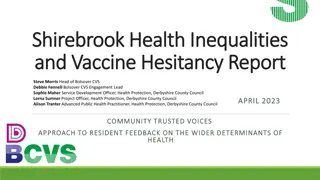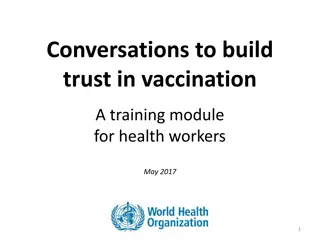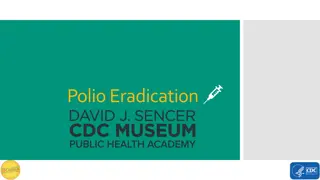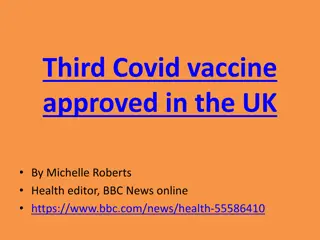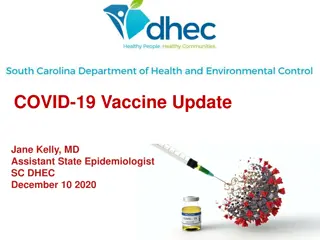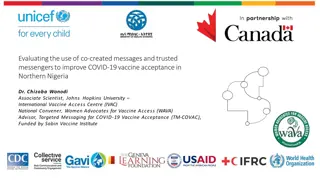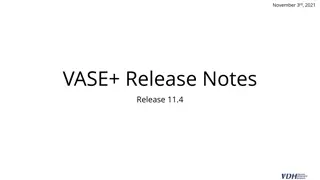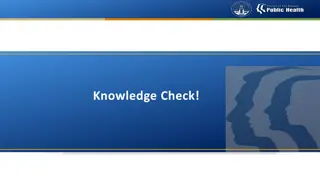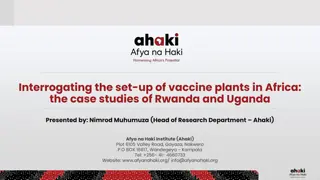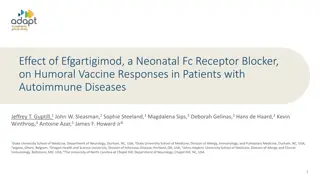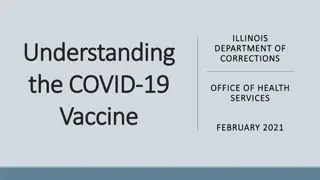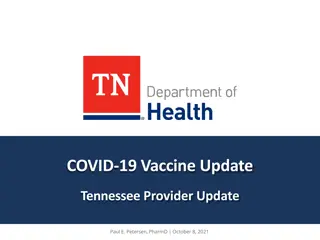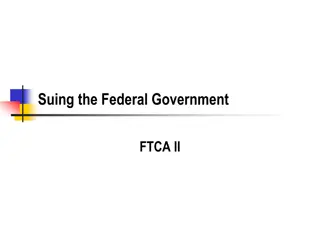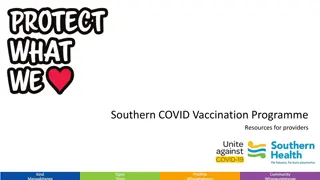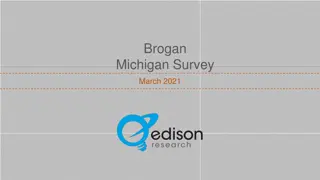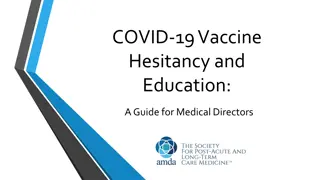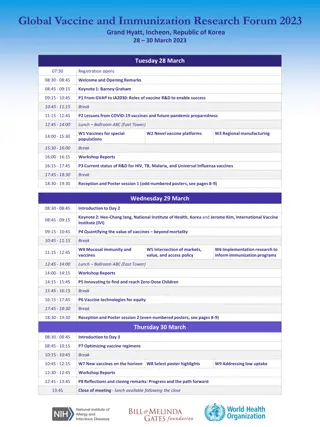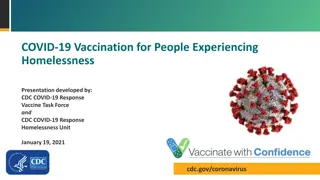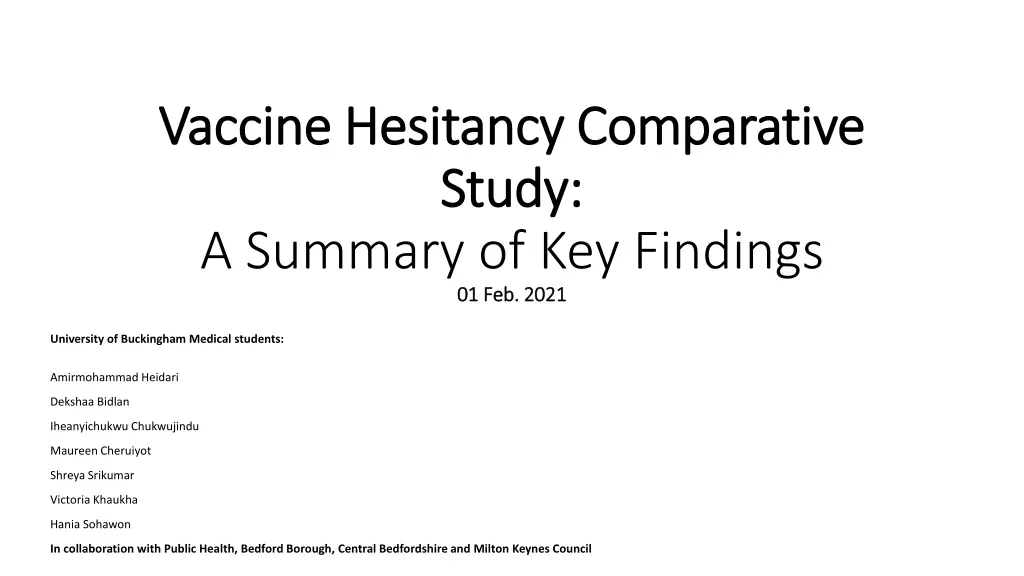
Understanding COVID-19 Vaccine Hesitancy: Key Findings & Recommendations
This comparative study explores COVID-19 vaccine hesitancy, common barriers, and enablers, along with misinformation and conspiracy theories. Key points for specific communities, including pregnant women and ethnic groups, are highlighted to promote vaccine uptake.
Download Presentation

Please find below an Image/Link to download the presentation.
The content on the website is provided AS IS for your information and personal use only. It may not be sold, licensed, or shared on other websites without obtaining consent from the author. If you encounter any issues during the download, it is possible that the publisher has removed the file from their server.
You are allowed to download the files provided on this website for personal or commercial use, subject to the condition that they are used lawfully. All files are the property of their respective owners.
The content on the website is provided AS IS for your information and personal use only. It may not be sold, licensed, or shared on other websites without obtaining consent from the author.
E N D
Presentation Transcript
Vaccine Vaccine Hesitancy Hesitancy C Comparative Study: Study: A Summary of Key Findings 01 Feb. 2021 01 Feb. 2021 omparative University of Buckingham Medical students: Amirmohammad Heidari Dekshaa Bidlan Iheanyichukwu Chukwujindu Maureen Cheruiyot Shreya Srikumar Victoria Khaukha Hania Sohawon In collaboration with Public Health, Bedford Borough, Central Bedfordshire and Milton Keynes Council
Methodology 13 Articles relating to Vaccine hesitancy were reviewed including the most recent studies from Luton, Bradford and Hertfordshire Local Authorities
Common barriers found in COVID-19 vaccine studies, but also similar themes seen in other vaccine studies and conspiracy theories Lack of endorsement by trusted community leaders
Common enablers very specific to the COVID-19 vaccine
Common misinformation/conspiracy theories Common misinformation/conspiracy theories Beliefs of harmful side effects, e.g. During pregnancy teratogenic contents Microchips to track individuals The Pandemic not as serious 'Man-made virus' theories reinforcing confusion and hesitancy The belief that certain ethnic groups were targeted Leaders, social media and anti-vaccination activists dissuading groups of people from taking vaccination.
Key points for particular communities Key points for particular communities Pregnant women (not a COVID-19 study) The single most important factor in maternal vaccination uptake is healthcare professional recommendation Beliefs that vaccine could cause birth defects or general harm in pregnancy Black British groups, followed by Pakistani/Bangladeshi groups Beliefs that certain ethnic communities were targeted by the vaccine Not clear if truly associated: Perception of risk Low confidence in vaccines Distrust Access barriers Lack of communication from trusted providers and community leaders
Common recommendations Common recommendations
COVID COVID- -19 19 specific recommendations specific recommendations Tailored communication: Multilingual and supported by sources trusted by the communities Specific concerns of communities such as dietary practices or ethics should be addressed Community engagement using trusted individuals from the community Regular reporting on the vaccination including minority groups Increasing accessibility and safety of vaccination sites
References References Bateman, W., Deo, R., Nocco, L., Constable, M. and Chadwick, P. (2020). COVID-19 Vaccination: Reducing vaccine hesitancy Review & Recommendations. Bromley, J. (2020). Luton Vaccine Study: Primary Research into Vaccine Hesitancy. Freeman, Daniel, et al. COVID-19 Vaccine Hesitancy in the UK: The Oxford Coronavirus Explanations, Attitudes, and Narratives Survey (OCEANS) II. Psychological Medicine, 11 Dec. 2020, pp. 1 34, www.cambridge.org/core/journals/psychological-medicine/article/covid19-vaccine-hesitancy-in-the-uk-the-oxford-coronavirus-explanations-attitudes-and- narratives-survey-oceans-ii/C30FDB5C3D87123F28E351FDAAD5351A, 10.1017/S0033291720005188. Karafillakis, E. and Larson, H.J. (2017). The benefit of the doubt or doubts over benefits? A systematic literature review of perceived risks of vaccines in European populations. Vaccine, [online] 35(37), pp.4840 4850. Available at: https://www.sciencedirect.com/science/article/pii/S0264410X17309696. Kilich, E., Dada, S., Francis, M.R., Tazare, J., Chico, R.M., Paterson, P. and Larson, H.J. (2020). Factors that influence vaccination decision-making among pregnant women: A systematic review and meta-analysis. PLoS ONE, [online] 15(7). Available at: https://www.ncbi.nlm.nih.gov/pmc/articles/PMC7347125/ [Accessed 31 Jan. 2021]. Lawes-Wickwar, S., Ghio, D., Tang, M.Y., Keyworth, C., Stanescu, S., Westbrook, J., Jenkinson, E., Kassianos, A.P., Scanlan, D., Garnett, N., Laidlaw, L., Howlett, N., Carr, N., Stanulewicz, N., Guest, E., Watson, D., Sutherland, L., Byrne-Davis, L., Chater, A. and Hart, J. (2021). A Rapid Systematic Review of Public Responses to Health Messages Encouraging Vaccination against Infectious Diseases in a Pandemic or Epidemic. Vaccines, 9(2), p.72. Lewandowsky, S. (2021). The COVID-19 Vaccine Communication Handbook. [online] HackMD. Available at: https://hackmd.io/@scibehC19vax/home [Accessed 31 Jan. 2021]. Lockyer, B., Islam, S., Rahman, A. and Dickerson, J. (2020). Understanding Covid-19 misinformation and vaccine hesitancy in context: Findings from a qualitative study involving citizens in Bradford, UK. [online] medrxiv.org. Available at: https://www.medrxiv.org/content/10.1101/2020.12.22.20248259v1 [Accessed 31 Jan. 2021]. Royal Society for Public Health (2019). MOVING THE NEEDLE: Promoting vaccination uptake across the life course. Schmid, P., Rauber, D., Betsch, C., Lidolt, G. and Denker, M.-L. (2017). Barriers of Influenza Vaccination Intention and Behavior A Systematic Review of Influenza Vaccine Hesitancy, 2005 2016. PLOS ONE, [online] 12(1), p.e0170550. Available at: https://journals.plos.org/plosone/article?id=10.1371/journal.pone.0170550. Scientific Advisory Group for Emergencies (2020). Factors influencing COVID-19 vaccine uptake among minority ethnic groups, 17 December 2020. [online] GOV.UK. Available at: https://www.gov.uk/government/publications/factors-influencing-covid-19-vaccine-uptake-among-minority-ethnic-groups-17-december-2020. Williams, Lynn, et al. Social Patterning and Stability of Intention to Accept a COVID-19 Vaccine in Scotland: Will Those Most at Risk Accept a Vaccine? Vaccines, vol. 9, no. 1, 4 Jan. 2021, pubmed.ncbi.nlm.nih.gov/33406762/, 10.3390/vaccines9010017. Wilson, K., Nguyen, Holdt Henningsen, Brehaut and Hoe (2011). Acceptance of a pandemic influenza vaccine: a systematic review of surveys of the general public. Infection and Drug Resistance, p.197.

